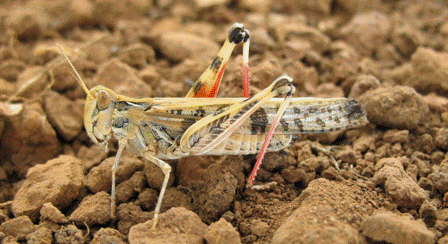AUSTRALIAN plague locust numbers remained very low over spring and the summer outlook is for very low population densities to continue in most regions of inland eastern Australia, according to the Australian Plagues Locust Commission (APLC).
Only occasional adults were recorded on APLC surveys over spring and no nymphs were observed.
Heavy rainfall at the start of November in parts of western Queensland and New South Wales produced a green vegetation response, creating opportunities for some low density breeding during the month.
Surveys in the central west and south central regions of Queensland at the end of October recorded only occasional adults, while low density adults were identified in the Central Highlands.
The low density population identified in north west and south west Queensland in September is likely to have declined due to continued drought conditions.
Surveys in New South Wales in late October identified very few locusts in the Riverina and Central West regions.
Surveys in the far west and far south west regions recorded no locusts. The Bourke and Cobar districts of the far west region received heavy rainfall in early November, with more widespread light–moderate falls in the Riverina, far south west regions.
Previous surveys in the north east region of South Australia in October recorded no locusts. There was no significant rainfall in SA during November.
Limited surveys in north west Victoria in October did not detect any locusts. Locust numbers are expected to remain very low throughout Victoria.
Low threat outlook
The summer outlook is for very low population densities of Australian plague locusts to continue in most regions of inland eastern Australia.
Only low density breeding was possible in habitats that received heavy rainfall (>40mm) at the start of November and localised nymphs could develop in central west Queensland and far west NSW during December.
However, the very low adult population is only likely to produce low density nymphs and vegetation will dry out rapidly in the absence of further rain.
Habitats in other regions will remain unfavourable with only limited breeding possible.
The Bureau of Meteorology seasonal outlook indicates that below average rainfall and above average temperatures are likely to continue over coming months.
There is a low likelihood of high-density populations or regional infestations developing in any inland region during summer.
Spur-throated locust
The summer breeding population level of spur-throated locusts remains very low.
Surveys during 2018-19 indicate the current adult population is one of the lowest on record in the regions covered. Surveys during spring 2019 recorded only occasional low density adults in Queensland.
Surveys of the central west, Central Highlands and parts of south central Queensland at the end of October recorded only occasional adults in areas associated with residual green vegetation. No adults were recorded in NSW, Victoria or SA.
Localised heavy rainfall in parts of the Queensland Central Highlands and central west at the start of November produced a short-lived vegetation response and some localised suitable breeding habitat.
However, the very low background breeding population could produce only low density nymphs and there is likely to be high mortality without further significant rainfall.
There is a very low risk of a widespread infestation developing during summer or autumn 2020.
Migratory locust
There were no recordings of migratory locusts on any surveys during spring.
Migratory locust habitats have become increasingly dry in the Queensland Central Highlands, south central and central west regions where this species is more commonly observed.
However, heavy rainfall in parts of the central west region could have initiated some low density breeding during November.
Given the very low prior adult population level, this is unlikely to produce more than occasional nymphs.
There is a very low risk of a widespread infestation developing during summer.
Source: APLC
Report any locust activity be reported as soon as possible to your local biosecurity authority, primary industries department or to the commission. A toll-free call to the APLC can be made on 1800 635 962. An answering machine is attached to this phone for after-hours calls.
Reports can also be emailed to APLC at [email protected] or made through the website at http://www.agriculture.gov.au/aplc


HAVE YOUR SAY